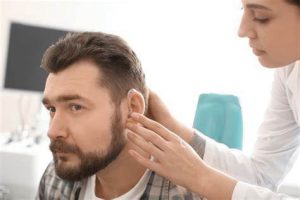 As we age, our hearing gradually deteriorates – sometimes so gradually that we aren’t even aware that we’re blasting the TV and talking too loudly in restaurants. According to National Health and Nutritional Examination Surveys, over 48 million Americans aged 12 years and older have a hearing loss.
As we age, our hearing gradually deteriorates – sometimes so gradually that we aren’t even aware that we’re blasting the TV and talking too loudly in restaurants. According to National Health and Nutritional Examination Surveys, over 48 million Americans aged 12 years and older have a hearing loss.
“Approximately 80 percent of people with hearing loss will go untreated and, of those who do receive treatment, the average person will wait seven years after being diagnosed with a hearing loss until deciding to pursue treatment,” notes Dr. Chelsea Steer, Au.D., audiologist with Mid America Audiology Group, which has seven offices in the St. Louis metro area. “More and more studies are linking hearing loss to social isolation, depression, cognitive decline, increase in falls and decrease in annual income. The importance of treating hearing loss, at any age, has become increasingly evident.”
Hearing loss and tinnitus can be caused by several things, including the normal aging process, exposure to excessive loud noise, ear infections or other medical conditions of the ear, and trauma to the ear from contact with a foreign object. Certain medications can cause hearing loss and/or tinnitus, head trauma and some hearing loss can be hereditary, says Dr. Steer.
TREATING HEARING LOSS
Hearing healthcare experts at Mid America Audiology Group are trained to diagnose and treat hearing loss and tinnitus with the latest American-made hearing aid technology. Each hearing aid purchase comes with a 60-day trial period, so you have plenty of time to make sure you have the device that fits your needs, includes free lifetime service, including adjustments and in-office repairs.
Most insurance plans of union members have a hearing aid benefit. This could mean no out-of-pocket costs. To find out if your insurance plan covers hearing aids, call Mid America Audiology Group at 618-462-7900 or 888-531-6036.
HEARING AID STYLES
Hearing aids are available in many sizes and styles thanks to advancements in digital technology and miniaturization of the internal components. Many of today’s hearing aids are considered sleek, compact and innovative, offering solutions to a wide range of hearing aid wearers.
IN-THE-EAR
The “largest” of the in-the-ear products, the ITE offers greater options for power to fit more severe hearing losses, space to accommodate a variety of options, larger battery size and ease of manipulation. ITEs can also connect directly to cell phones and be compatible with remote controls and other wireless features.
IN-THE-CANAL
In-the-canal hearing aids sit in the lower portion of the outer ear bowl, providing for a more discreet fit. Typically in-the-canal or ITC hearing aids can still house many of the features of a full in-the-ear aid but are designed for less severe hearing losses. ITCs can also still connect directly to cell phones and be compatible with remote controls or other wireless features.
COMPLETELY-IN-CANAL
Completely-in-canal aids are more discreet as they are almost completely hidden, yet still large enough to house advanced features. Many CICs can also still connect directly to cell phones and be compatible with remote controls or other wireless features.
INVISIBLE-IN-CANAL
Invisible-in-the-canal aids are completely invisible when your ear anatomy allows for it – wide enough, tall enough, and angled just right. Due to their small size, they can be limited in power and additional features, though some do allow for wireless capabilities.
BEHIND-THE-EAR
Behind-the-ear (BTE) hearing aids sit behind/on top of the outer ear with the sound directed by a tube or wire into the ear canal. The instruments are manufactured in a variety of different colors to accommodate skin or hair color. BTE hearing aids also come in a variety of sizes and the actual style is best determined by you and our doctors, as various styles can accommodate different features, power levels, control options and battery sizes.
RECEIVER-IN-CANAL
This style of device is popular due to its inconspicuous nature and its comfort. Sound travels into the ear canal through a thin tube or via a wire – with the receiver placed directly in the ear canal. Mini behind-the-ear aids can also connect directly to cell phones and be compatible with remote controls and other wireless features.
TAKE A HEARING QUIZ ONLINE
You can visit Mid America Audiology Group’s website, www.midamericaaudiologygroup.com, to take a five-minute hearing quiz to help you determine if you show signs of a hearing loss. Mid America Audiology Group focuses on diagnostic evaluations and treatment of hearing loss and balance disorders. This practice has been established for more than 30 years and has three audiologists and one hearing instrument specialist. The practice provides treatment options that include hearing devices, aural rehabilitation, tinnitus therapy, and counseling to help patients communicate better. The Alton location also offers vestibular (balance) evaluations and treatment of certain types of balance disorders.
To find out more about hearing loss and Mid America Audiology Group, call 618-462-7900 or 888-531-6036.

